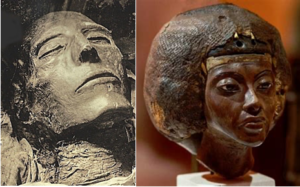To the Ends of the Earth: Lost White Migrations and Civilizations, Part 5
 Sidney Secular
Sidney Secular
December 20, 2023
Great Zimbabwe – the Scottish Picts
Evidence suggests the ancient Picts of Scotland — not the Bantus as some claim – were the builders of the enigmatic African citadel of Great Zimbabwe. Modern history has devolved from attempts at discovering facts into racial politics so that the Blacks can claim accomplishments where their connections to the forward march of progress are tenuous and trivial at best. This has been to allow Blacks to “feel good” about themselves as a race. This is obvious in the current “historical” nonsense of permitting Blacks to take credit for the advanced civilization of ancient Egypt although there is infinite proof that at its zenith, this civilization was White and only began to deteriorate as Blacks become an influence. But, of course, if history can be ignored in the north of the continent, why not do the same at the other end at the ruins of a late Iron Age site in southeastern Africa called Great Zimbabwe? At one time, it was the largest population center in sub-Saharan Africa (see below)
 Pharoah Seti I ………………Queen Tiye
Pharoah Seti I ………………Queen Tiye
Pharoah Seti I was the second King of the 19th Dynasty during the New Kingdom period, ruling about 1294 or 1290 BCE to 1279 BCE. He was the father of Rameses II, also known as Rameses The Great.
Queen Tiye (also known as Tiy, 1398-1338 BCE) reigned in the 20th Dynasty. She was the wife of the pharaoh Amenhotep III, mother of Akhenaten, and grandmother of both Tutankhamun and Ankhsenamun. This was a period of great strife in Egypt.
The principal structure at the main site of “The Great Zimbabwe” is a conical tower, which tapers gradually inwardly towards the top to give it stability. It is composed of granite stones of varying sizes matched together like a great jigsaw puzzle with no mortar to hold it together, obtained from the surrounding countryside. It is 30 feet high, and 18 feet wide at its base. It is only one of about 300 stone structures of varying size and shape enclosed within a circular wall similarly constructed of stones, which is an incredible 20 feet thick, 36 feet high, and 820 feet in circumference, creating a fort-like appearance. It really wasn’t a fort because one could walk into it through its unimpeded entrances and it displayed no defense-type features. There were about 200 small scale replicas of the main “fortification” which one could think of as “suburbs.”
Monumental structures in pre-historic and early historic times often were just used for storage and ceremonial purposes and were not fortifications or domestic residences in the sense we think of them. Stored in the “facilities” within the “fort” were a variety of objects, many composed of gold. Six-hundred fifty tons of gold were found lying about within the “fort”, which was but a fraction of the gold mined in the immediate vicinity. In addition to the said gold, there were a variety of objects and jewelry crafted from gold including beads, bracelets, pendants and sheaths. In a similar vein, there were a variety of elaborately worked objects composed of ivory, copper, and iron, including ingots, wire, crucibles, gongs, and agricultural equipment.
The inhabitants apparently were engaged in a lucrative and worldwide trade involving objects obtained from or sent to various places. Syrian glass beads, Arabian and Roman coins, Chinese pottery, and Persian ceramics were found at the site. Such trade would require a fleet of seaworthy vessels capable of traversing long distances. The international commerce was supplemented by regional agricultural abundance including large scale cattle raising. None of these accomplishments were known to exist in the rest of sub-Saharan Africa when, indeed, the wheel was unknown.
There is a wide difference or divergence of opinion as to when the complex was established and who established it, the time periods ranging from that of King Solomon to the First Century, A.D. to just before 1,500 A.D. Some consider the site to be the mysterious Ophir, the place at which King Solomon’s legendary mines may have been located while others consider the site to actually be the Great Zimbabwe. To some, the Phoenicians (a people who did construct conical towers) and medieval Arabs have been cited as the founders of the site. But today, that is the age of political correctness run amuck, present day Black nationalists have claimed that the local Bantu tribes established the site and had slaves that did the agricultural work associated with it. By far, however, the most likely creators of the localized civilization were the Picts, a Celtic tribe that occupied north and northeastern Scotland for at least 1,000 years but who disappeared as a separate people when they were assimilated into other Celtic tribes moving into the area, a process that was completed by about 800 A.D.
But before that assimilation occurred, some of these White people apparently made the 8,000 mile voyage from Scotland the southeastern Africa. Now this is hardly impossible as there were already White people making such trips about the world as can be seen by the Roman invasion of Britain! And there is other proof as, for instance, the fort-like “Great Enclosure” of Great Zimbabwe is almost an exact replica of borh Clickimin Loch or Mousa Broch in Scotland, structures that were creations of those same Picts and had already been in existence 2,000 years ago. The conical Great Zimbabwe tower is a typical dry-stone building of this type that is found only in Scotland, even to their mutually shared height of 44 feet. Inside the Mousa Broch, archeologists recovered a three-foot long model of a prehistoric deep sea vessel carved from fir wood. The vessel itself would have been 40 feet in length, with a particular hull style specifically designed to ride out high waves. It would have been eminently seaworthy and therefore sufficient to carry the Picts from Scotland to southeast Africa.
Radiocarbon testing of various building materials at the Zimbabwe site show that different eras were involved in creating and modifying the site with the earliest consisting of a large crossbeam installed during the reign of the Roman Emperor Antonius Pius circa 138 A.D. Some construction work was conducted around 600 A.D. and some modifications were being conducted immediately before abandonment of the site around 1,450 A.D. due to a prolonged drought that caused drastic water shortages and resultant famine. Historically, a major arrival of Pict settlers appears to have occurred around 590 A.D. which coincided with the abandonment of the Clickimin Loch in Scotland.
Nor is this just speculation. The local Bantus have tribal recollections of a foreign race of coming among them and known as the “Pink Men” for their red hair and rosy complexions as creators of the site. These recollections described the newcomers as having blue, green or brown eyes with some having long flowing black or yellow hair as well as those with red hair. One of the “Pink People” appears to have been depicted in a large display of rock art called the “Great Man of Chamavara”. a complementary work of rock art known as the “Woman of Chamavara” shows pale skin, long-flowing red hair, baggy pants, pointed shoes, and shoulder armor similar to that worn by the Classical Greeks.
The Pict presence in Scotland is proved by a large groups of standing stones completely covered with carved circular and spiral symbols. The Picts also created a blue-colored paste from the Woad plant with which they decorated their bodies with symbology and tattoos similar to that depicted on the standing stones. The English derivative words “picture’ and “depiction” directly refer to the decorative arts for which the Picts were famous.
Select bibliography:
- Garlake, Peter. Great Zimbabwe: New Aspects of Archaeology. London. Thames & Hudson, 1973.
- Houghton, Brian. History’s Mysteries. NJ. New Page Books, 2010.
- Mallows, Wilfrid. The Mystery of the Great Zimbabwe: A New Solution. NY: Norton, 1984.
- Childress, David Hatcher. Lost Cities & Ancient Mysteries of Africa & Arabia. IL: Adventures Unlimited Press, 1989.
© 2023 Sidney Secular – All Rights Reserved
E-Mail Sidney Secular: Success_Express@yahoo.com